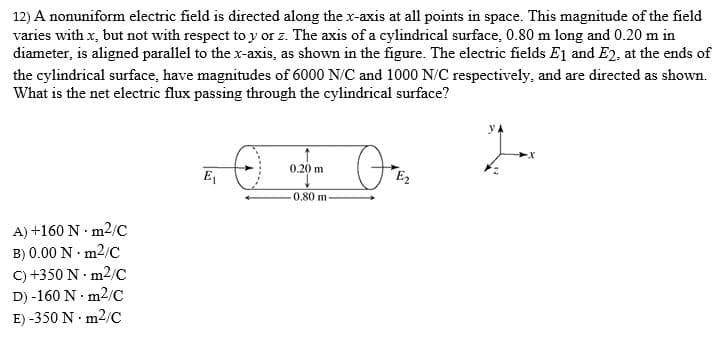12) A nonuniform electric field is directed along the x-axis at all points in space. This magnitude of the field varies with x, but not with respect to y or z. The axis of a cylindrical surface, 0.80 m long and 0.20 m in diameter, is aligned parallel to the x-axis, as shown in the figure. The electric fields E1 and E2, at the ends of the cylindrical surface, have magnitudes of 6000 N/C and 1000 N/C respectively, and are directed as shown. What is the net electric flux passing through the cylindrical surface? y A On 0.20 m E E2 0.80 m A) +160 N · m2/C B) 0.00 N · m2/C C) +350 N· m2/C D) -160 N m2/C E) -350 N · m2/C
12) A nonuniform electric field is directed along the x-axis at all points in space. This magnitude of the field varies with x, but not with respect to y or z. The axis of a cylindrical surface, 0.80 m long and 0.20 m in diameter, is aligned parallel to the x-axis, as shown in the figure. The electric fields E1 and E2, at the ends of the cylindrical surface, have magnitudes of 6000 N/C and 1000 N/C respectively, and are directed as shown. What is the net electric flux passing through the cylindrical surface? y A On 0.20 m E E2 0.80 m A) +160 N · m2/C B) 0.00 N · m2/C C) +350 N· m2/C D) -160 N m2/C E) -350 N · m2/C
Physics for Scientists and Engineers, Technology Update (No access codes included)
9th Edition
ISBN:9781305116399
Author:Raymond A. Serway, John W. Jewett
Publisher:Raymond A. Serway, John W. Jewett
Chapter24: Gauss’s Law
Section: Chapter Questions
Problem 24.59AP: A uniformly charged spherical shell with positive surface charge density contains a circular hole...
Related questions
Question
q12

Transcribed Image Text:12) A nonuniform electric field is directed along the x-axis at all points in space. This magnitude of the field
varies with x, but not with respect to y or z. The axis of a cylindrical surface, 0.80 m long and 0.20 m in
diameter, is aligned parallel to the x-axis, as shown in the figure. The electric fields E1 and E2, at the ends of
the cylindrical surface, have magnitudes of 6000 N/C and 1000 N/C respectively, and are directed as shown.
What is the net electric flux passing through the cylindrical surface?
y A
On
0.20 m
E
E2
0.80 m
A) +160 N · m2/C
B) 0.00 N · m2/C
C) +350 N · m2/C
D) -160 N · m2/C
E) -350 N · m2/C
Expert Solution
This question has been solved!
Explore an expertly crafted, step-by-step solution for a thorough understanding of key concepts.
This is a popular solution!
Trending now
This is a popular solution!
Step by step
Solved in 2 steps

Knowledge Booster
Learn more about
Need a deep-dive on the concept behind this application? Look no further. Learn more about this topic, physics and related others by exploring similar questions and additional content below.Recommended textbooks for you

Physics for Scientists and Engineers, Technology …
Physics
ISBN:
9781305116399
Author:
Raymond A. Serway, John W. Jewett
Publisher:
Cengage Learning

Principles of Physics: A Calculus-Based Text
Physics
ISBN:
9781133104261
Author:
Raymond A. Serway, John W. Jewett
Publisher:
Cengage Learning

Physics for Scientists and Engineers
Physics
ISBN:
9781337553278
Author:
Raymond A. Serway, John W. Jewett
Publisher:
Cengage Learning

Physics for Scientists and Engineers, Technology …
Physics
ISBN:
9781305116399
Author:
Raymond A. Serway, John W. Jewett
Publisher:
Cengage Learning

Principles of Physics: A Calculus-Based Text
Physics
ISBN:
9781133104261
Author:
Raymond A. Serway, John W. Jewett
Publisher:
Cengage Learning

Physics for Scientists and Engineers
Physics
ISBN:
9781337553278
Author:
Raymond A. Serway, John W. Jewett
Publisher:
Cengage Learning

College Physics
Physics
ISBN:
9781285737027
Author:
Raymond A. Serway, Chris Vuille
Publisher:
Cengage Learning

College Physics
Physics
ISBN:
9781305952300
Author:
Raymond A. Serway, Chris Vuille
Publisher:
Cengage Learning

College Physics
Physics
ISBN:
9781938168000
Author:
Paul Peter Urone, Roger Hinrichs
Publisher:
OpenStax College